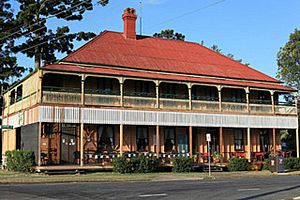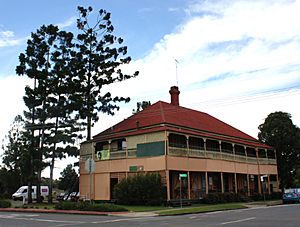Marburg Hotel facts for kids
Quick facts for kids Marburg Hotel |
|
|---|---|

Marburg Hotel, 2012
|
|
| Location | Edmond Street, Marburg, City of Ipswich, Queensland, Australia |
| Design period | 1870s - 1890s (late 19th century) |
| Built | c. 1881 - c. 1890 |
| Official name: Marburg Hotel | |
| Type | state heritage (built) |
| Designated | 21 October 1992 |
| Reference no. | 600732 |
| Significant period | 1880s, 1890s (fabric) 1881-ongoing (social; historical use) |
| Significant components | kitchen/kitchen house |
| Lua error in Module:Location_map at line 420: attempt to index field 'wikibase' (a nil value). | |
The Marburg Hotel is a historic building located on Edmond Street in Marburg, Queensland, Australia. It was built a long time ago, between about 1881 and 1890. This hotel is very important to the area's history. Because of its special past, it was added to the Queensland Heritage Register on October 21, 1992. This means it's a protected site.
Contents
The Hotel's Early Days
The Marburg Hotel first opened its doors around 1881. It was built for a farmer and hotel owner named Weigand Raabe. At first, it was a single-storey building. The land for the hotel was bought in mid-1880. By June 1881, the hotel was already a busy spot, hosting races and sports events. It was one of the very first buildings in Marburg and the town's first hotel.
Marburg's Growth and the Hotel
The Marburg area was mainly settled by German families. In the early 1870s, they worked hard to clear the thick forests to create farms. By late 1885, about 5,000 people lived in the district. The town of Marburg grew quickly. It had a Court House, a School of Arts, a primary school, and two hotels. It even had electricity supplied by a local sawmill.
After Weigand Raabe passed away in 1883, his wife, Auguste Raabe, took over the hotel. She later married Otto Sakrzewski, who was a storekeeper and carpenter in Marburg. Otto then managed the hotel for several years.
A Family's Long Connection
In 1890, Otto Sakrzewski took out a large loan for the property. It's thought that the second floor of the hotel was added around this time. The Sakrzewski family continued to run the hotel until 1921. They owned the building until 1925.
Over the years, the hotel had a few different owners. In 1936, a company called Queensland Brewery Ltd bought it. Since 1947, the Marburg Hotel has been the only hotel in the town. The Bowden family has owned the hotel since 1986. They have also been the people running the hotel since about 1944.
A Landmark for Travelers
The Marburg Hotel is one of the oldest buildings still standing in the town. It has been open continuously as a hotel since 1881. From 1923 to 1969, the main highway between Brisbane and Toowoomba passed right through Marburg. During this time, the hotel was a well-known landmark. It was a popular place for travelers to stop and rest.
What the Hotel Looks Like
The Marburg Hotel is a two-storey building made of timber. It has a corrugated iron roof that slopes downwards from all sides, called a hipped roof. You can find it on the corner of Queen and Edmond Streets, right in the middle of Marburg. It's across from the old Queensland National Bank and the World War I memorial. That memorial is now the Marburg Community Centre and First World War Memorial.
The parts of the building that face the streets have two-storey verandahs. These verandahs run along the entire length of the building. They are held up by strong timber posts. The street-facing walls show their timber frames, which are crisscrossed for strength. The walls at the back of the building are covered with flat timber boards called chamferboards.
The verandahs on the first floor have pretty decorative cast iron designs. The roof of the verandah is a curved corrugated iron awning. The ground floor verandahs have big signs for advertising where the original decorative trim used to be. You can enter the public bar from the verandah through the front corner door.
The building stands on timber stumps, which are like short wooden legs. At the back, there's a separate, single-storey kitchen house. It's also made of chamferboard. It's connected to the main hotel by a covered walkway and an open deck.
The ground floor of the hotel has the public areas, and it has been changed quite a bit over time. The first floor is where the guest rooms are. Most of these rooms still have their original layout. The inside walls are made of single layers of tongue and groove timber boards. The doors on the ground floor have small windows above them called fanlights. On the first floor, the doors have decorative wooden panels above them called fretwork. Rooms open onto the verandahs through french doors. The rooms at the back of the building have sash windows with decorative metal hoods over them.
Why the Hotel is Important
The Marburg Hotel is listed on the Queensland Heritage Register for several reasons. It's important because:
- It shows how Queensland's history developed. The hotel was built around 1881 and had additions around 1890. It shows how Marburg grew into an important farming community in the 1880s.
- It shows what a typical old hotel looked like. The hotel still has many of its original features, especially its street views and upper floor. This helps us understand what rural hotels were like in Queensland in the late 1800s.
- It is beautiful and important to the community. The hotel's size, shape, and materials make it a valued part of the Marburg streetscape. It's a landmark that shows where the town center is.
- It has a special connection with the Marburg community. The hotel has been a big part of Marburg's social life since 1881. It's also part of a historic area in the town center. This area includes the old Queensland National Bank, the First World War memorial (now the Marburg Community Centre and First World War Memorial), and the old Walloon Shire Council Office (now the Rosewood Scrub Historical Society Building).


